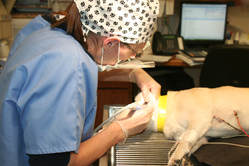
Protecting Your Pet’s Dental Health at Dodgeville Veterinary Service
Just like in humans, infection and inflammation of the gums and supporting tissues of the teeth are caused by bacteria present in plaque and tartar. When tartar builds up on your pet’s teeth, it can lead to bad breath, bleeding, receding gums, and even eventual tooth loss.
All the veterinarians believe the centerpiece of good dental care is a complete oral exam followed by a thorough cleaning designed to remove plaque and slow its buildup.
At Dodgeville Veterinary Service, your pet’s dental appointment includes:
- Oral examinations under anesthesia
- Diagnosis and treatment of periodontal disease
- Digital dental radiographs
- Supra and subgingival scaling using an ultrasonic scaler
- Tooth extractions
- Polishing
- Irrigation
- Fluoride application
Should we find any issues, such as evidence of gum or tooth erosion, gingivitis, or excessive plaque buildup, we will discuss this with you and offer treatment options for your pet. We are experienced dental practitioners and can offer many dental procedures and oral surgeries.
Caring for Your Pet’s Teeth and Gums at Home
You can prevent serious dental problems by making sure your pet receives dental exams at the time of each vaccination, again at 6 months of age, and then annually. In between visits to your veterinarian at Dodgeville Veterinary Service, check your pet’s teeth regularly for signs of problems. Brushing your pet’s teeth is the single most important procedure you can do to maintain good oral health. If performed regularly, brushing dramatically decreases the incidence of gingivitis and can increase the interval between teeth cleaning appointments.
If you’re unsure of how to brush your pet’s teeth, please ask a staff member at Dodgeville Veterinary Service for instructions. We’re happy to help.
Signs of Pet Dental Problems
Halitosis, or bad breath, is the most common sign of dental disease. Classic “doggy breath” is not necessarily normal. The major cause of halitosis is periodontal disease. This is an infection of the gums and potentially the other supporting structures of the teeth. Plaque builds up every day on the tooth surface including at the gum line.
If left in place, the plaque can mineralize, or harden, in less than two days, forming calculus or tartar. The continued build-up of tartar above and below the gum line can eventually produce an environment for certain types of bacteria that may be more destructive to the periodontal tissues and also produce a more noticeable odor.
Other symptoms of dental disease include:
- A yellowish-brown crust of plaque on the teeth near the gum line
- Red and swollen gums
- Pain or bleeding when your pet eats or when the mouth or gums are touched
- Decreased appetite or difficulty eating
- Loose or missing teeth
To prevent your cherished pet from developing painful and infectious conditions, it is important to keep his/her teeth clean and healthy.
